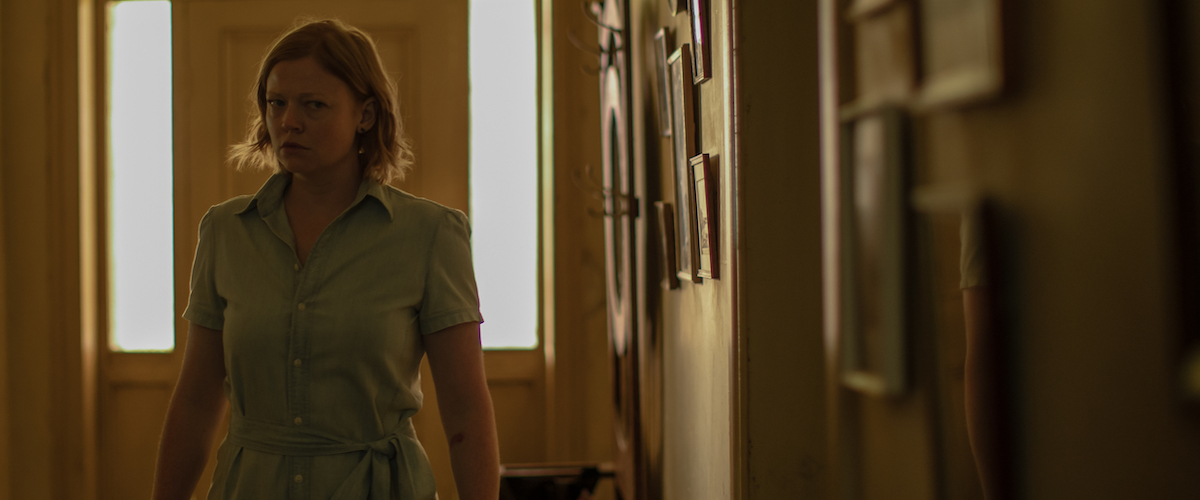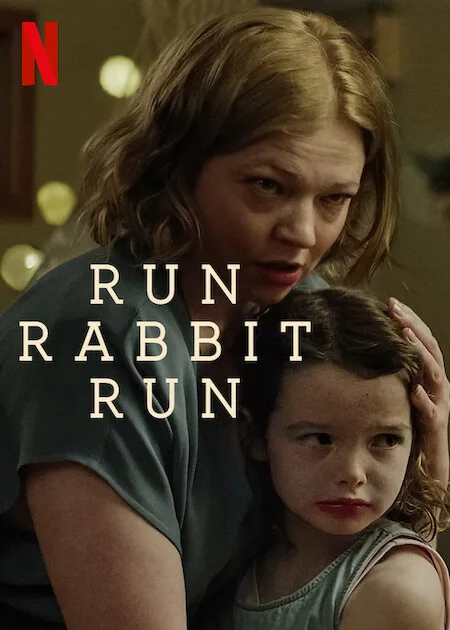The topic of motherhood has long provided the horror genre with some of its greatest stories. From “Rosemary’s Baby” to “The Babadook,” there is something inherently scary about watching your beloved child be overtaken by evil forces or reckoning with the idea that becoming a parent makes us vulnerable to just about every terrible thing in our world (and beyond). In Daina Reid’s new film “Run Rabbit Run,” fertility doctor Sarah (Sarah Snook) meets these tensions head-on when her precocious seven-year-old daughter Mia (Lily LaTorre) begins to claim she’s actually Alice, Sarah’s sister who disappeared when she was Mia’s age.
Reid’s ghost story uses innocuous objects to emphasize the film’s sense of unease. First, Mia shows up with a white fluffy rabbit and quickly becomes obsessed with it, to the point where she begins wearing a self-made pink rabbit mask. The bunny, which she names Rabbit, ominously hops around the house, a harbinger of the bad things still to come. When Sarah tries to get rid of Rabbit, it bites her, the first of many injuries she will incur as she spirals over memories of her missing sister, her estranged mother, and her recently departed father. The film’s conflict is centered between mother Sarah, and daughter Mia, but it also includes a thorny relationship with Sarah’s mother, Joan (Greta Scacchi), creating a cycle of guilt from childhood sins and feeling like she’s not doing enough for her kid.
Rabbit is not the only troubling thing in Hannah Kent’s script. In setting up Sarah’s narrative, Kent shows the audience how much Sarah’s been pushed to the brink even before anything unexplained begins. She’s divorced and co-parenting with her ex-husband, Pete (Damon Herriman), who has moved on and is starting a new family of his own. Sarah is also dealing with the death of her dad, his things are still piled up in her garage, still to be sorted through. And then there’s her mother, an ominous figure also losing her memories to dementia. When Mia’s problems escalate, she first tries to be the strong parent doing what’s right for her child, but then, she starts to hurt herself in the process and by extension, hurts Mia.
In a marvelous departure from her best-known role as Shiv Roy in “Succession,” Snook brings her character a motherly sense of care and duty. She’s attentive and affectionate in ways many of us haven’t seen her. Her calm, collected demeanor quickly erodes in the face of uncertainty and stress. Snook’s attention and care for LaTorre’s Mia are deeply felt, and their bond is evident from the first scene when the mother wakes up her daughter with a birthday gift. LaTorre looks at Snook with large expressive eyes that shift from confused and scared when she’s inexplicably bleeding to burning with rage when she screams that she’s actually Alice. But in moments of Mia’s clarity, LaTorre runs to Snook and embraces her tightly for safety, establishing the close relationship between the pair early on, giving us a sense of what will be lost once Rabbit enters the frame.
Sarah’s descent into madness mirrors the haunting landscape of the film’s setting in Waikerie, Australia. There ate windswept horizons, imposing cliffs, stormy clouds over luscious green hills, flutters of birds flying in droves by her old home, and what looks like trees sprouting out of a purple river. The film wallows in a weatherbeaten palette, with lots of pale yellows and dusty grays in the daytime. At night, darkness takes over, and even well-lit homes and cozy bedrooms start to feel unsafe. Cinematographer Bonnie Elliot carefully plays with these moods to create a visual sense of Sarah’s spiral. The film’s aesthetic becomes increasingly erratic as she loses her grip on reality. When Sarah goes in and out of a dreamlike state, images may look hazy or disorienting in their closeup, then harshly come into focus when she returns to reality. When Sarah starts to lose control, Snook physically takes her character to that dark place, but the film’s camera immerses the viewer in her unease.
Motherhood, like extreme moments of grief, can be among the most life-changing experiences—a clear demarcation of life before and after the event. Sometimes, it can also be coupled with extreme feelings of isolation, which in this horror movie, makes a person vulnerable to the ghosts of their past. “Run Rabbit Run” is a solid, spooky tale without anything too flashy like a Babadook to haunt our dreams and memes but chilling enough to make us sit up in our chairs and scan the screen for the next sign of danger. While a fluffy white rabbit may symbolize innocence, it leads Sarah down a nightmarish version of “Alice in Wonderland.” The mothers in this film are haunted by the mistakes they made. Joan never seemed to have recovered from Alice’s disappearance, and Sarah’s barely buried trauma resurfaces her own feelings of regret over failing her daughter. And once Sarah is through the looking glass, are she and Mia safe? Are any of us?
On Netflix now.




















